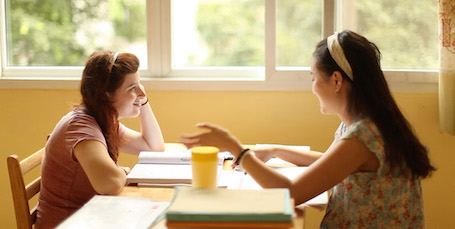The Shanghai Bund Travel Guide: What to See, Do and Know
Learn Chinese in China or on Zoom and gain fluency in Chinese!
Join CLI and learn Chinese with your personal team of Mandarin teachers online or in person at the CLI Center in Guilin, China.
The Bund—Shanghai’s prominent waterfront promenade—is a must-see for travelers to China’s most dynamic metropolis. Visiting the Bund is an unforgettable experience that provides a window into the history and modern ascension of the world’s third largest city. Read on to learn more.

A brief introduction to the Bund
The Bund, also known as Waitan (外滩 Wàitān), is a protected, historical waterfront area in Shanghai, China, that measures 0.93 miles (1.5 km) long.
It runs along the eastern section of Zhongshan Road (中山路 Zhōngshānlù), which borders the western banks of the Huangpu River.

The Bund is one of the most iconic destinations in Asia.
History of the Bund
During the colonial period, the Western powers made various attempts to dominate China and open the country to trade and Western settlement. China under the Qing dynasty government resisted.
After losing the First Opium War to the British in 1842, however, China was forced to open up five of its major ports, including Shanghai, to foreign trade. As a result, the British were granted the right to settle along the Huangpu River where the Bund is today.
In 1863, the British and the Americans worked together to establish the International Settlement, which saw the Bund grow further. Between the 1860’s and 1930’s, the Bund was the most government-protected foreign establishment in the whole of Shanghai.
In the late 19th century, British colonial style and neoclassical buildings were built along the Bund. The early 20th century saw the additional construction of buildings housing offices of many important financial institutions on the Bund. These included the Hong Kong Shanghai Banking Corporation (HSBC) and the Imperial Bank of China (the first Chinese-owned bank in Shanghai).
Today, the Bund features a host of historical Western-style buildings built in a variety of architectural styles.

Many of the Bund’s historical buildings were built by British and American residents of Shanghai.
What makes the Bund famous?
The Bund is famous for being home to 52 historical Western-style buildings which date from the late 19th to early 20th centuries. These buildings include representative examples of various architectural styles like Romanesque, Baroque, Gothic, Renaissance, and Neoclassical Revival.
This collection of iconic buildings includes the Asia Building, which once housed the offices of the Asiatic Petroleum Company; the Union Building, which initially housed multiple insurance companies but is now a shopping complex; and the old HSBC Building, which is now home to the Shanghai Pudong Development Bank.
Another notable building on the Bund is the China Merchants Bank Building.
Overall, the 52 historical buildings along the Bund serve as a reminder of the role of Western colonial influence in the city’s history and development.
Today, these buildings are a living museum and collectively, they make up one of the most visited destinations for travelers in China.
Must-dos at the Bund
The Bund has so much to offer. Check out the following list to discover some of the most popular sites and attractions on this storied stretch of road.
Here are some of the things you must do during your visit to the Bund:
1. Stroll along the Bund
There is no better way to appreciate the architectural beauty of all of the Bund’s 52 historical buildings than to walk along the 0.93-mile (1.5-km) stretch of waterfront they occupy.
It will likely take you around two and a half hours, but these may be your most memorable two and half hours in Shanghai.
Strolling along the Bund allows you to intimately explore its 52 timeless structures while looking across Huangpu River to marvel at the iconic Lujiazui skyline. Shanghai’s modern skyline across the river from the Bund features some of the city’s most famous buildings, like the Shanghai Tower and the Oriental Pearl Tower.
Just remember to carry some water and an umbrella or raincoat in case the weather changes.

Walking along the Bund is a great way to get a feel for modern Shanghai.
2. Cruise along Huangpu River
If you don’t like the idea of walking for two and half hours along the Bund, consider going on a ferry cruise along the Huangpu River. Taking a cruise will allow you to marvel at the contrast between the Bund’s historical buildings and the modern skyscrapers of Lujiazui.
There are several ways to see the Bund from the river. If you want to save money and experience the Bund like a local, you can take a ferry ride across Huangpu to Pudong from the Bund. This allows you to explore both sides of the Huangpu River for only 2 yuan.
Alternatively, you can cruise the Huangpu in a modern boat and even enjoy a traditional Shanghainese meal. These cruises last 30-50 minutes and run day and night. A 30-minute cruise costs about 150 yuan ($22).
No matter whether you opt for a ferry or a luxury cruise, consider taking your boat ride at night. Shanghai’s dazzling lights create the most magnificent display on the water after dark.

Take a cruise on the Huangpu for amazing views of many of Shanghai’s most memorable buildings.
3. Relax at Huangpu Park
After a long walk or cruise, consider relaxing at Huangpu Park. This small oasis is one of the most tranquil places in the whole of Shanghai.
Its lush, well-maintained lawns are lovely for cooling off, meditating, or just taking some fantastic photos.
4. Watch the locals exercise
The Bund waterfront offers wide stretches of sidewalk that locals consider fantastic spots for exercising. If you visit at dawn or dusk, you can usually catch some Shanghai residents on their morning jogs or engaging in evening tai chi (太极拳 tàijí quán) sessions.
You can observe from a distance or even join in if you want to burn some extra calories. Overall, exercising on the Bund is an exciting way to experience the local lifestyle.

Practicing tai chi (太极拳 tàijí quán) on the Bund is a popular local pastime.
5. Capture panoramic photos
A visit to the Bund provides the ultimate opportunity for taking panoramic photos of Shanghai’s impressive skyline.
By either standing on the walkway alongside the Bund’s waterfront or by taking a cruise on the Huangpu River, you can capture amazing photos of many iconic buildings that are located across the river from the Bund. These include Shanghai Tower, Jin Mao Tower and the Shanghai World Financial Center.

The Bund is the best place to capture panoramic photos of the Lujiazui skyline.
Must-sees at the Bund
Many people who visit the Bund simply come to take photos and view the façades of the historical buildings.
While the Bund is certainly picturesque when viewed from a distance, taking time to admire the interiors of the buildings and visit some of the other Bund attractions adds a whole new level to the experience.
Keep in mind that most of the buildings on the Bund are still in use and may not always be open to visitors. That said, it is often possible, and fascinating, to peek inside the lobbies of many of the Bund’s most historic buildings.
Below is our list of top things to see up close when you visit the Bund:
1. Old HSBC Building
The Old HSBC (Hong Kong and Shanghai Banking Corporation) Building is a six-story neoclassical building that served as the headquarters of the HSBC from around 1923 to 1955. This impressive historic structure once held the distinction of being the second largest bank building in the world and the largest in the Far East.
Currently, the building, situated at number 12, is home to the Shanghai Pudong Development Bank.
The Old HSBC Building is an architectural masterpiece that is likely to fascinate anyone with an interest in the history of globalization.
Its biggest attraction is its architectural design, which features a large central dome in the entrance hall. The dome is decorated with colorful mosaics depicting scenery from important trading cities in which HSBC had branches at the time it was constructed. These cities included Hong Kong, Tokyo, London, New York, Bangkok, Paris and Calcutta.
If you’re curious about what the Bangkok or Calcutta skyline looked like circa 1923, a visit to this building should be high on your list of things to do.

The Old HSBC Building was once the largest bank building in the Far East.
2. Custom House
The Custom House is an 8-story building that dates to 1927. Located just next to the old HSBC building at number 13, the Custom House is known for its iconic clock tower. In fact, it is modeled after Big Ben in London.
Interestingly, the Custom House still functions as a customs house today.
Together with the Old HSBC Building, the Custom House is seen as a symbol of the Bund and the whole of Shanghai.

The Custom House clock tower is one of the most memorable structures on the Bund.
3. The Bund Bull (Shanghai Bull)
The Bund Bull, popularly known as the Shanghai Bull, stands at 3.2 meters (10.5 feet ) high and is about 5.2 meters (17 feet ) long, making it almost identical in size to the Wall Street Bull.
Crafted by Italian-American sculptor Arturo Di Modica, the Bund Bull represents the virulence of China’s economy. It was unveiled on the Bund in 2010, just after the global financial crisis. The Bund Bull serves as a reflection of the strength and energy of Shanghai’s economy.

The Bund Bull is a symbol of modern China’s economic strength. It will likely remind many visitors of its counterpart on Wall Street in New York City.
4. Gutzlaff Signal Tower
Also known as the Bund Weather Tower, the Gutzlaff Signal Tower is a 36.8 meter tall Art Deco-style signal station initially built to offer weather forecasts and typhoon alerts for the Huangpu River. Although it was rebuilt several times, the original tower was built in 1865.
Today, the tower houses a museum about the history of the Bund on its first floor and a café on its second.

Visit the Gutzlaff Signal Tower museum to learn more about the history of the Bund.
5. The Bund Sightseeing Tunnel
The Bund Sightseeing Tunnel is an underwater passageway that connects the Bund to the nearby Pudong District. Its construction began in 1998, but the tunnel was launched in 2000.
Since then, it has been popular with visitors who want to explore the other side of the Huangpu River after visiting the Bund. You’ll love the sound and light effects that come with the tunnel adventure.
The ride through the tunnel to Pudong takes 3-5 minutes and offers a 360-degree view of the Bund and its surroundings. A one-way ride costs about 50 RMB, while a two-way ride goes for 70 RMB. You can enjoy this adventure from 8 AM to 10 PM.
6. The Peace Hotel
The Peace Hotel is one of the most important and well-known historical landmarks on the Bund.
A famous fixture of old Shanghai, this Art Deco masterpiece has been featured in several movies and novels. The hotel has hosted legions of international celebrities and remains one of the Bund’s most iconic structures.
Note that the Peace Hotel is actually a set of two buildings. First, there is the Swatch Art Peace Hotel, which was initially the Palace Hotel. Second, there is the Fairmont Peace Hotel, which still functions as a luxury hotel today.
Even if you don’t plan to stay at the Peace Hotel during your stay, consider dining at one of its six exquisite restaurants. Most of the first floor is open to visitors. There is also a small museum which you can visit to learn about the history of the building.

You can recognize the Peace Hotel by its green roof, which is actually made of corroded copper.
Best time of day to visit the Bund
The best time to visit the Bund is generally in the morning or afternoon on sunny, clear days. It is best to visit when the weather is nice because the view across the water to Lujiazui is the most picturesque when the weather is good.
For those interested in taking a look inside some of the historical buildings along the Bund, visiting during business hours on weekdays is a good idea.

Visiting the Bund on a clear, sunny day will give you the best view of Lujiazui.
How to get to the Bund
You can get to the Bund using any of these routes:
By bus
Catch bus number 133 or 135 from Zhongshan Park.
By ferry
Catch a ferry ride from Pudong.
By metro
There aren’t any metro stations directly on the Bund, but you can take the Shanghai metro to nearby Nanjing Road East Station (南京东路站 Nánjīngdōnglù Zhàn), take Exit 2 and then walk towards the iconic Oriental Pearl Tower for about 10 minutes to get to the Bund.

Taking the Shanghai metro to Nanjing Road East Station (南京东路站 Nánjīngdōnglù Zhàn) and walking about 10 minutes east is our recommended mode of transportation for accessing the Bund.
What to eat and drink at the Bund
The area around the Bund offers you access to an array of exquisite restaurants and local eateries. Plan a visit or drop by one and taste some of the best cuisine China has to offer.
Must-try dishes include steamed crab, peking duck and braised pork, which you can take with dumpling soup or green tea.
Many of the restaurants on or near the Bund can be quite expensive, so you might want to avoid them if you are on a budget.

Crayfish are a popular treat among Shanghai locals and visitors alike.
Nearby attractions
After exploring the Bund, you can also visit the following nearby attractions:
Nanjing East Road (南京东路 Nánjīngdōnglù)
Nanjing East Road, Shanghai’s busiest street, is lined with high-end shopping malls, local eateries, and name-brand stores.
A visit to Nanjing East Road allows you to shop for traditional Chinese crafts and modern delights. There are over 500 stores along the road, offering a variety of different shopping experiences.

Nanjing East Road is a major shopping destination that’s not to be missed.
Waibaidu Bridge (外白渡桥 Wàibáidù Qiáo)
There’s no better spot near the Bund for watching the sunset than the Waibaidu Bridge. Waibaidu is a historical, Western-designed steel bridge that spans Suzhou Creek.
Also called the Garden Bridge in English, the current bridge was built in 1907 and is the only example of a camelback truss bridge in China today. Thanks to its long history, it is a popular symbol of Shanghai.
The bridge, which offers spectacular views of the Bund and Shanghai at large, is a popular spot for shooting TV shows and movies. It has even been featured in several Chinese novels.

Waibaidu Bridge is a Shanghai landmark that makes frequent appearances in TV shows and movies.
Yuyuan Garden (豫园 Yùyuán)
Yuyuan Garden, also known as Yu Garden and the Happiest Garden, is a green oasis modeled after the famous Suzhou gardens that allows visitors to experience a vast collection of classical Chinese buildings scattered amidst charming ponds, bridges and rockery.
The 20,000 square meter garden dates back to the Ming dynasty and is a great destination for those looking to learn about traditional Chinese landscaping techniques without leaving Shanghai.
After visiting the garden, don’t forget to stop by nearby Yuyuan Bazaar, a famous street featuring local restaurants and craft stores.

Yuyuan Garden is a great place to see traditional Chinese architecture in the heart of Shanghai.
The Bund: Where Shanghai’s past and future meet
The Bund, with its well-preserved Western-style historical buildings and stunning views of Shanghai’s modern Lujiazui skyline, is truly at the heart of Shanghai.
If you only have a couple of hours to spend in the city, you should spend them here. The Bund is at the meeting point of East and West, past and future. Visit the Bund today to discover one of Shanghai’s most iconic spots.
After visiting Shanghai, we recommend making time to visit some nearby cities to get a more well-rounded understanding of modern China. Check out our travel guides on neighboring cities like Suzhou, Hangzhou and Wuzhen to help you plan your trip.

Visit the Bund to gain fascinating insights into Shanghai’s past, present and future.
The CLI team is comprised of China experts with advanced degrees in China studies, teaching Chinese as a foreign language, education, and other related disciplines. Founded in 2009, CLI is a center for Chinese language and cultural studies based in scenic Guilin, China.













